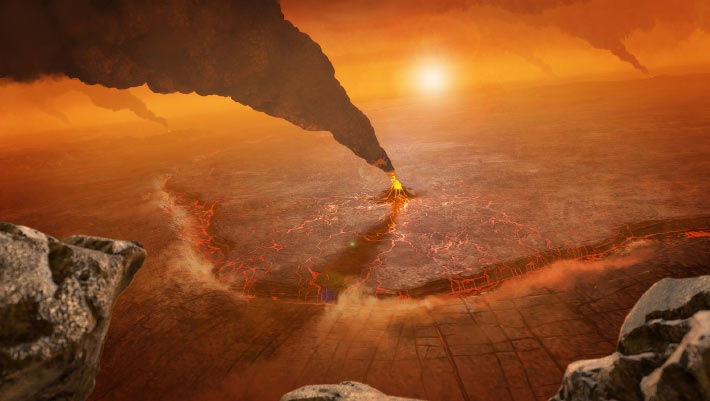Earth has a hot core that heats the surrounding mantle, which carries that heat up to the planet’s lithosphere. The heat is then lost to space, cooling the uppermost region of the mantle. This mantle convection drives tectonic processes on the surface, keeping a patchwork of mobile plates in motion. Venus, which is Earth’s twin in size, doesn’t have tectonic plates, so how the planet loses its heat and what processes shape its surface have been long-running questions in planetary science. In a new study, planetary scientists looked at the mystery using observations NASA’s Magellan mission made in the early 1990s of quasi-circular geological features on Venus called coronae. Making new measurements of coronae visible in the Magellan images, they concluded that coronae tend to be located where the planet’s lithosphere is at its thinnest and most active.
An artist’s concept of active volcanoes on Venus, depicting a subduction zone where the foreground crust plunges into the planet’s interior at the topographic trench. Image credit: NASA / JPL-Caltech / Peter Rubin.
“For so long we’ve been locked into this idea that Venus’ lithosphere is stagnant and thick, but our view is now evolving,” said Dr. Suzanne Smrekar, a researcher at NASA’s Jet Propulsion Laboratory.
“Just as a thin bedsheet releases more body heat than a thick comforter, a thin lithosphere allows more heat to escape from the planet’s interior via buoyant plumes of molten rock rising to the outer layer.”
“Typically, where there’s enhanced heat flow, there’s increased volcanic activity below the surface.”
“So coronae likely reveal locations where active geology is shaping Venus’ surface today.”
In their study, Dr. Smrekar and colleagues focused on 65 previously unstudied coronae that are up to a few hundred km across.
To calculate the thickness of the lithosphere surrounding them, they measured the depth of the trenches and ridges around each corona.
What they found is that ridges are spaced more closely together in areas where the lithosphere is more flexible, or elastic.
By applying a computer model of how an elastic lithosphere bends, they determined that, on average, the lithosphere around each corona is about 11 km (7 miles) thick — much thinner than previous studies suggest.
These regions have an estimated heat flow that is greater than Earth’s average, suggesting that coronae are geologically active.
“While Venus doesn’t have Earth-style tectonics, these regions of thin lithosphere appear to be allowing significant amounts of heat to escape, similar to areas where new tectonic plates form on Earth’s seafloor,” Dr. Smrekar said.
To calculate how old a celestial body’s surface material is, planetary scientists count the number of visible impact craters.
For a tectonically active planet like Earth, impact craters are erased by the subduction of continental plates and covered by molten rock from volcanoes.
If Venus lacks tectonic activity and the regular churn of Earth-like geology, it should be covered in old craters.
But by counting the number of Venusian craters, scientists estimate that the surface is relatively young.
Recent studies suggest the youthful appearance of Venus’ surface is likely due to volcanic activity, which drives regional resurfacing today.
This finding is supported by the new research indicating higher heat flow in coronae regions — a state that Earth’s lithosphere may have resembled in the past.
“What’s interesting is that Venus provides a window into the past to help us better understand how Earth may have looked over 2.5 billion years ago. It’s in a state that is predicted to occur before a planet forms tectonic plates,” said Dr. Smrekar, who is also the principal investigator of NASA’s forthcoming Venus Emissivity, Radio science, InSAR, Topography, And Spectroscopy (VERITAS) mission.
The study appears in the journal Nature Geoscience.
_____
S.E. Smrekar et al. 2023. Earth-like lithospheric thickness and heat flow on Venus consistent with active rifting. Nat. Geosci 16, 13-18; doi: 10.1038/s41561-022-01068-0




